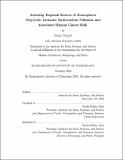Assessing Regional Sources of Atmospheric Polycyclic Aromatic Hydrocarbon Pollution and Associated Human Cancer Risk
Author(s)
Trivedi, Disha
DownloadThesis PDF (2.559Mb)
Advisor
Selin, Noelle Eckley
Terms of use
Metadata
Show full item recordAbstract
Atmospheric pollution from organic matter burning poses health risks to humans across the globe, making it crucial to assess and regulate such pollution’s sources. One class of atmospheric pollutants, toxic, carcinogenic polycyclic aromatic hydrocarbons (PAHs), are globally ubiquitous chemicals of interest to domestic and international policy decision-makers. Previous studies of PAHs use a single carcinogenic PAH, benzo[a]pyrene, to perform policy-relevant analyses of PAH sources and health effects. However, a new study from Kelly et al., (2021) suggests that BAP may not represent pollution and health effects of other carcinogenic PAHs and their degradation products. Kelly et al.’s findings suggest that previous BAP-based analyses may not capture the PAH emissions sources responsible for PAH concentrations and cancer risk in policy-relevant regions. This thesis uses Kelly et al.’s extended version of the global, three-dimensional GEOS-Chem atmospheric chemistry model to simulate concentrations of BAP and of 48 PAHs and degradation products in three policy-relevant regions: the Arctic Circle, the continental United States, and East Asia. This thesis performs source receptor analysis by simulating BAP (“the BAP simulation”) and simulating 48 PAHs (“the 48-PAH simulation”). In the Arctic, simulating 48 PAHs demonstrates that outside-Arctic sources, primarily from sub-Arctic Russia and continental Europe, contribute a higher percentage of Arctic PAH pollution and cancer risk than simulating BAP alone attributes. However, a high percentage of Arctic PAH concentrations come from within-Arctic sources in the BAP simulation and the 48-PAH simulation. In the United States, simulating 48 PAHs identifies single-digit contributions from outside-US sources, predominantly from sub-Arctic Canada and the Arctic, that are missed when simulating BAP alone. Geospatial mapping of these simulations indicates that Arctic wildfire emissions are likely responsible these sub-Arctic Canadian and Arctic contributions to US PAHs as well as of within-Arctic sources of Arctic PAHs. In East Asia, simulating BAP and simulating 48 PAHs show that within-East Asian sources contribute almost all of East Asian PAH concentrations and associated cancer risk. Overall, these source attribution findings demonstrate the saliency of multifactor PAH assessments, such as the 48-PAH simulation, to identifying outside-region sources of interest to stakeholders like the United Nations Economic Commission for Europe’s Convention on Long-Range Transboundary Air Pollution and the Arctic Council.
Date issued
2023-02Department
Massachusetts Institute of Technology. Institute for Data, Systems, and SocietyPublisher
Massachusetts Institute of Technology